5.22.2008
Saucisson sec preparation
Before tackling Ruhlman's saucisson sec, I needed a place for the sausage to undergo curing for about 3 weeks at 50°F and at least 60% relative humidity (RH). My beer fridge usually only has a single keg in it and I decided to tweak this chamber a bit to see if I could achieve a steady temperature/RH.
Baseline for the beer fridge is 45°F and 30-35% RH. Too dry. I thought some water in the bottom might increase the humidity. It did, to about 40%. After a number of different substrates placed in the fridge failed, I thought about increasing the water temperature by using a variable temperature hot pot. It's not a trivial problem. The fridge has a thermostat, the hot pot at a higher temperature will cause an increase in the vapor pressure of the water resulting in a higher humidity and finally the interdependence of the temperature and relative humidity make this environment nearly impossible to predict or calculate outcomes.
Empiricism to the rescue. I was able to fine tune both the fridge setting and hot pot setting to achieve the following boundary conditions:
38-40°F/40%RH with the hot pot on lowest setting (off)
48-50°F/68-70%RH with the hot pot at 90°F.
Also, at 90°F, the water barely evaporates over the course of 24 hours.
I have to have that kind of flexibility because of what Andrew warned me of. When the fresh sausage goes in for a cure, it loses water over time, thus increasing the humidity inside the chamber. Consequently, I need to be able to decrease the humidity contributed by the water bath to maintain a constant interior RH as the sausage cures.
I have some long term monitoring to do to validate the setup, but I'm confident enough, and the sausage ingredients are inexpensive enough to take a stab at it. Andrew, I may take you up on your generosity of the sausage stuffer loan, I can't wait any longer.
5.20.2008
Tilapia en papillote
Years ago while visiting a friend in Dijon, she made us a splendid meal in minutes from a few fish fillets and some veggies in her fridge. Layering a cleaned fillet with veggies and flavoring each layer with a dash of salt and pepper, dotting the whole mixture with lemon juice and olive oil and baking gave us a lovely fresh meal served with rice. Here's my attempt at recreating the special meal we had.
The only thing missing from the image is a topping with a chiffonade of fresh basil.

I wrapped and crimped the parchment to contain the fish and veggies and went on to preheat the oven and prepare the brown basmati side. The oven was preheated to 450-deg-F and the sheet tossed in the oven for about 15 minutes. The baking sheet was removed using a pizza peel revealing 3 pouches speckled with burn marks, but still nicely sealed and smelling wonderful. I let the pouches rest a few minutes and opened mine as a test case to make sure the fish was cooked properly. It flaked nicely and the aroma was enticing. The lemon and steamed zucchini and tomatoes laced with basil made me especially hungry.
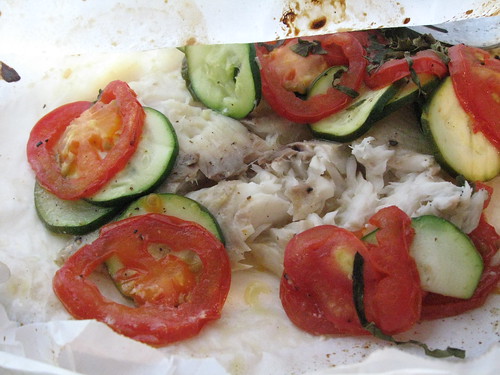
Here's a view of my packet opened. I slid the food off on to the plate. It was a lovely fresh tasting meal we will enjoy again.
5.18.2008
On mindfulness and diet: it's about balance

Mrs. Dave's Beer and I have recently come face to face with the harsh reality that our metabolism is slightly different than it was when we met, in our twenties. At the beginning of the year, we suddenly realized, our portion size was too big, the beloved meat portion dominated the plate and desserts were too common. We needed to take action and didn't want to give up good food.
Within a month we:
• Reduced the portion size of our meal, especially pasta.
• The presence of a vegetable on our plate was NOT an option, but has become a front and center part of the meal leaving the delectable meat portion the dinner-version of a dessert; something to appreciate and savor.
• The starch portion: whether it be pasta or rice has become a much more complex form of grain; a whole wheat couscous, a brown basmati /orzo pilaf, etc. Good alternatives are abundant.
• Legumes are a frequent replacement for meat, lentils especially. Cooked and spiced properly, they are a perfect protein component as satisfying as meat.
• While we're not enemies of enriched unbleached white (I still buy mine in 25 lb bags), we've always been aware of the problem with stripped down unbleached white being the foundation of too many preparations. One minor counter of this, we started having a variety of whole grain cooked cereals for breakfast (an unbelievably nice change) instead of white flour pancakes.
• Incorporating whole grains into fresh pasta (dry and fresh).
• Substitution of a fraction of the unbleached white with a higher grain. While this may bring back flashbacks of the disasters of substituting fat with apple juice concentrate in bran muffins, it is often a substitution yielding great results.
• Fruit is abundant in our home and always available for snacking. Frankie enjoys a ripe kiwi fruit or banana as much as a crappy corn syrup-based Spiderman gummy treat. She gets the latter on occasion, she's a kid.
There are many other alterations to our diet we've made that are not only healthy, but better, give us more variety and are easy to maintain. These changes are part of a permanent change in our lives and we're enjoying food more than ever. Since January, we've lost only a few pounds, but, more importantly, stemmed a scary trend we nearly gave in to as inevitable.
Why the cookie image at the top of the post? Desserts are not only allowed in our diet, but special. These cookies are simply the Toll House recipe on the back of the semi-sweet chip bag - butter and all. These were made by Frankie under the tutelage of Mrs. Dave's Beer substituting only one thing. King Arthur's white whole wheat (a flour I'm enjoying the more I used it, available at Weiland's) for half of the flour bill. Although these cookies are hardly healthy, the substitution afforded a serendipitous benefit. They were actually better than the original. They taunt us whenever we go into the kitchen.
We gave away tons and still have too many on hand. I'm afraid they won't go to waste. It's a bit decadent, but the diet's still reasonably balanced.
5.11.2008
Charcuterie, A book that will change my life (a little).
"Embrace the sausage." p. 100
Cookbook authors are notorious for making unsubstantiated, general statements. They are often authoritative sounding, but hardly methodological. I haven't purchased a cookbook in years. I recently borrowed Ruhlman and Polcyn's Charcuterie: The Craft of Salting, Smoking, and Curing. This is more of a fun text than it is a cookbook. Soon, I'll have to buy it.
The chapter on sausage making is worth the price of the book. The authors are rigorous in their safe preparation of the tastiest and least expensive cuts of meat. A central theme in the book is flavorful, but tough, fatty cuts of meat can be tenderized by mechanical means as an alternative to long cooking methods like braising. I learned grinding meat isn't just pounding a piece through the grinding attachment of your Kitchen Aid (I can assure you, that careless approach does NOT work). It requires attention to sanitation, careful measurement and temperature control. They use mass rather than volumetric measurement throughout the book, essential to any accurate preparation description. The techniques aren't hard, but attention to them will result in a truly special piece of meat rather than relying on the corporate-level sausage skills of the big meat houses.
Just a few items I can't wait to do or have already found indispensable:
• A Carolina tangy barbecue sauce (it's already on my stove).
• Brining times based on cut of meat.
• How to make jerky from venison (we have a ton of venison on hand).
• Making pancetta from $2/lb pork belly.
• Merguez preparation (although Mediterranean Imports makes a great one).
• Grinding my own turkey breast for my special meatballs.
• Room temperature fermentation of vegetables to pickled vegetables.
• and soooo much more, can't wait to try more of the preps.
5.04.2008
Brined and hickory smoked

Last weekend and today, I scraped paint. Dangling from a 12' ladder (I know, pretty low, but I was practically frozen with fear), somehow I managed to save my emergency room $50 copay and stayed healthy. While scraping, I had my Weber working diligently for me while I cooked for the week.
I started with a dirt cheap chicken from Aldi. It was pretty frozen, even after a day in the fridge, it was still rock hard frozen. While I don't often brine anything with a bone in it, I took Andrew's advice and used a brine to both keep it moist and thaw it out. About 12 hours in the fridge, sitting in a brine (4T salt + 4T brown sugar/quart of water) thawed it out perfectly. I removed the bird, dabbed it dry, coated it with olive oil, lemon juice, salt, pepper and stuffed the cavity with herbs (rosemary, thyme, basil) and tossed it on the grill.
For this smoke session, I used some no name lump I bought at Weiland's mixed with pieces of hickory. A small pile of fuel (ca. 20 pieces and replenished with about 10 pieces after a couple hours or so) went for about 4-5 hours at a steady 300-deg-F. Unfortunately, I was pretty absorbed scraping and let the chicken go about 3 hours. I suspect it only needed about 2. Brine to the rescue! This is after the smoking.
I wrapped the bird (cooked last Sunday) and tossed it in the fridge. We didn't get to it until Wednesday. And, wow, was it nice. Light smoke flavor, moist and fell off the few bones holding it together. Nearly pulled chicken. We usually use a chicken for a regular dinner with roasted potatoes and veggies and the rest of the meat gets vacuum packed for a smoked chicken salad later. Both meals are amazing. Chicken is one of the easiest and best 'q preps. Nearly impossible to screw up, good yield, only takes a couple hours indirect (depending on your temp). We never get tired of this staple. I might reconsider brining even bone in chicken and pork. Got a mean looking picnic ready to go in my freezer.
Upcoming? Jim @ CMH Gourmand will be interviewing me for a podcast on his site. [Dave @ davesbeer.com for book deals. ]
4.23.2008
Focaccia: Type 00/Unbleached White Flour, Kneaded
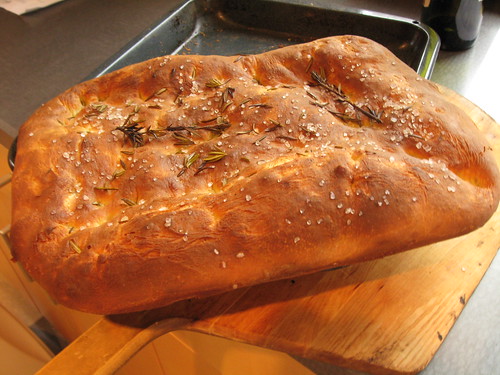
I like bread machines for kneading dough. I had my last one about 10 years and never baked a bread in it, although I used it about 2 times a week. I used it as dedicated equipment for kneading. Don't have to clean the bowl when finished and it works tirelessly. It can also be programmed to pop out your pizza dough as you come in the house. When I tried using it to knead a lump of pasta dough, I destroyed it. Pasta dough can be pretty tough. Another failed experiment in the culinary sciences.
Recently, I bought some type 00 flour. I used King Arthur's brand, which is milled in the states to the same specifications of its Italian counterpart. Type 00 is milled to very fine particle size. The resulting bread doughs are very stretchy and particularly good for wafer thin pizza. The only downside I've noticed is bread dough derived from it tends to be a bit sticky. Sticky dough, in the early stages of kneading, can cause one to add too much flour and create too dry a dough.
One way around a sticky dough is to use a bread machine. The dough cycles on these things are long and efficient. You can watch the dough pass from a slack, sticky mess into a more developed, resilient dough without adding any additional flour.
For this focaccia, I used 1/2 unbleached white (225 g) and 1/2 type 00 (225 g). The rest of the ingredients are about the same as my pizza dough. Liquid used was water (150 g) and milk (150 g), honey (20 g), salt (7 g), instant active dry yeast (1 packet) and let the dough cycle take over. 1.5 hours later, I popped it out, squashed it down for a 10 minute rest and then formed it into a 10"x14" (or so) rectangle on a dark, porcelain covered steel pan, covered it in olive oil, speckled with coarse salt and added rosemary and let it proof about 20 minutes. I docked the surface with my fingers and baked it (425F convection) for 30 minutes (oops, about 5 minutes too long). It had a beautifully light interior. I was kicking myself for overcooking it but am inspired to repeat it.
I'll give a link for the type 00 flour, it's not too expensive - even with shipping. Comes in 2 lb bags and also can be purchased at Carfagna's.
4.18.2008
Evaporated Cane Juice vs. Granulated Sugar
After reading Kashi's apple bake recipe using evaporated cane juice, I was so angry, I had to do about 5 consecutive sun salutations to manage my anger. Evaporated cane juice and plain old sugar are unequivocally the same, α-D-fructofuranosyl β-D-glucopyranoside (aka, sucrose, table sugar). After studying a while, the only difference in the processes used to isolate these substances on an industrial scale is one goes through one processing step more than the other. That's it. Same crop, same molecule. The white granulated sugar requires more energy to produce. So, it should be more expensive, tougher on resources and more expensive to produce. However, it costs less than evaporated cane juice, because people want what sounds "natural", regardless of the truth. Domino wins.
The subtle difference in composition between the two is simply the evaporated cane juice (ECJ) has a teeny bit more vitamin A, C and calcium (in a 100 grams sample). Take a vitamin. Lots cheaper.
In the industry, substances are produced according to specifications. Each batch produced is analyzed to insure compliance with the specifications. Documentation of this analysis comes in the form of a certificate of analysis (CoA). These are available to compliance agencies and geeks who really want to know weird information. I emailed DominoSugar.com today to try to get a typical CoA for granulated white and ECJ (their product name for ECJ is Demerara). They would not give up a CoA, but did give me the full nutritional specifications for each product. See below, and save your money.
| Attribute | evaporated cane juice, 100 g | granulated sugar, 100 g |
| calories, kcal | 400 | 400 |
| total lipid (fat), g | 0 | 0 |
| protein, g | 0 | 0 |
| fiber, g | 0 | 0 |
| calcium, mg | 18 | 1 |
| iron, mg | 0.0 | 0 |
| potassium, g | 0 | 2 |
| sodium, mg | 0 | 0.5 |
| vitamin C, mg | 4 | 0 |
| vitamin A, mg | 83 | 0 |
| thiamine, mg | 0 | 0 |
| riboflavin, mg | 0 | 0.019 |
| niacin, mg | 0 | 0.000 |
| price, 5 lbs., $ | 8-10 | 1-3 |
Some sugar Frankie and I recrystallized from water over a couple weeks.

4.16.2008
What is it?
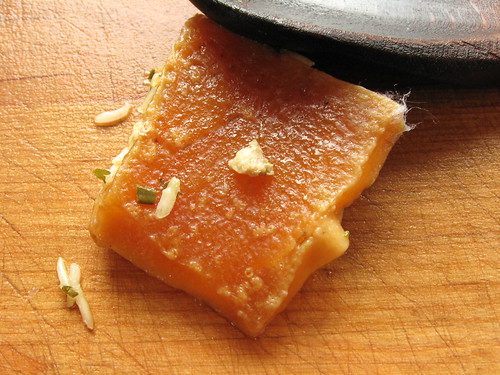
A while back Lisa posted an interesting food item post entitled Any Guesses?. Cool concept, hope she doesn't mind if I borrow the idea for a post.
I was making chicken soup (hint) the other night and pulled this out. Any guesses as to what it is? I was initially horrified until I remembered what it was.
4.12.2008
In which I come clean.
I've been trying desperately to control my Weber kettle to achieve 250 +/- 25-deg-F. Using the minion method (link in the right margin) I've not been able to do it. The minion method was developed specifically for the Weber Smokey Mountain. I've tried many times to apply it to a simple 22.5" kettle with little success. I usually get a hot initial burn (ca. 300-350) followed by a slow cooling over 5-6 hours to a final temp around 250 (and then it needs tending). I thought I was getting closer by closing the dome vent, but the fuel still heated things up too hot. This was done with the intent of achieving a constant temperature, without tending to the fire for at least 8 hours (overnight). The only way I've been able to get the temperature close to my desired setpoint is by feeding just a few pieces of fuel into the side at a time. This requires some attention every 3-4 hours. Not bad, but not what I wanted. My excitement in the past has been hopeful and biased, trying so desperately to see what I wanted, I almost ignored the data.
I am hanging my head in shame and will go back to the drawing board.
Last night, I did a control. An oven-controlled constant 250-deg-F on a picnic roast (cheaper than a Boston butt) with a light rub for 8-10 hours. It looks sublime. I wrapped it in foil and tossed it in the fridge. Soccer today, later this afternoon, I'll warm it up a bit and pull it. Pics later.
What next?? A trip to the dark side - electric??? Good steady LOW temps, slow smoking chips, all the attributes of a good low smoked piece of meat with no fire tending. Choice of busy parents everywhere. Problem with that option? Excommunication from the hallowed halls of Weber. Really expensive. Low end Brinkmann's have problems maintaining high temps due to thin steel contstruction (could be addressed by loading up the inside with some thermal mass - and - don't know if Mrs. Dave's Beer will allow another piece of equipment in the yard. (hint, hint). If I could apply some smoke via my oven, it'd be perfect, but smoking indoors is pretty much, uh, deadly I think.While I ponder these life changing events, have a peek at a lazyman's oven-mediated "pulled pork" run:
Please leave your thoughts in the comments.
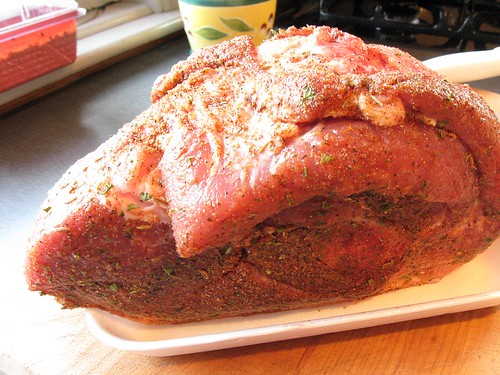
Started with a 4 lb picnic roast. About $5. Picnic is a shoulder cut lower on the shoulder than the Boston butt. It cost about half what a Boston butt costs and the taste is about the same. It's bone in too. I always make pulled from bone-in roasts. Oh, it's also dusted with my basic rib rub.

Here's the roast after cooking at 250-deg-F in the oven for 10 hours. It was sitting in rendered pork fat. I saved the pork fat to add dabs in my lentils. The finished product looks very much like a bronzed glorious piece of bacon - only bigger. This was removed from the pool of pork fat and wrapped while I went to the soccer game (Mustangs v. Wizards, tiny tots soccer).

Voila. After it was wrapped and in the fridge a few hours, I warmed it back up until barely warm, unrapped and shredded it effortlessly in my fingers. I must say, it was not smoky but perfect texture and moist. I got about 2 lbs. yield - almost, had a few samples for QC. For a fatty bone-in roast, that was a decent yield. We're having it tonight on wheat rolls (no coleslaw though, darn) with slow cooked black beans and a salad.
4.09.2008
It is NOT time for you to go Grasshopper (Smoked Tofu)
However, once we dust ourselves off and think about it, we're usually glad we did the experiment for the opportunity to modify, learn and to know what not to do so we can keep our friends from getting sick.
I marinated my tofu exactly as in Heidi's recipe, fired up the smoker and layered in a ton of apple wood. Then I tossed on the marinated lumps, closed up the grill and measured temps. I used my new data logger, the EL-USB-TC shown below. It was equipped with a "K"-type thermocouple and placed in the dome beside the thermometer I usually use. Below is an image of the data logger and below that, the corresponding temp profile for the 2 hour smoke.
![smoked tofu [3/5]](http://farm4.static.flickr.com/3220/2401562033_b9e86ce6cb.jpg)
The smoke went for a couple hours with a Tmax just above 300F. I closed the dome vent partially to bring it down and finally lifted the lid after two hours to reveal the final smoked tofu shown in the final image.
My wife and I eagerly placed a tender nugget in our mouths. While in some else's home, no member of our family is allowed to say anything derogatory about food served. But, we were home, and no one was around. It sucked. Bad. Texture was nice, but it sucked.
Post-Mortem
1. The lemon in the marinade clashed badly with the smoke.
2. For some reason, I thought a delicate food like tofu required a strong smoke blast. I couldn't have been more wrong. The opposite is probably more like it.
3. The lemon in the marinade clashed badly with the smoke.
Improvements?
With all the cool monitoring capabilities I now have, I can't stop. I'm considering a soy/sesame oil marinade and a hint of smoke for the next run, but I have lots to think about.
If I were on Top Chef, Padma would've told me to pack my knives.
4.08.2008
Grasshopper, you will know the path when it is right.
I am getting dangerously close to the dark side. Smoked Tofu.
Inspired by Heidi's marinated tofu and my recent experience smoking kielbasa, I'm preparing to try something I haven't observed yet. Application of smoking to explore new fusion cuisine. Tennessee meets Southern China.
I scored some apple smokewood at Weiland's Gourmet Market yesterday, as well as some extra firm tofu. The texture of kielbasa is similar to that of tofu. Fine grind, kind of amorphous, soft. I intend on smoking it for about 1-2 hours with a heavy dose of apple.
My friends on the Weber forum may never reply to my posts again. A risk I'm willing to take to take on new challenges.
4.04.2008
weber_cam will soon be so darn tedious, nobody will visit!
 I've been hunting for an affordable means to measure temperature over time between the range of about rt to about 400-500-deg-F. I have found it! This little baby is selling at MicroDaq for $82 and I jumped on it fast.
I've been hunting for an affordable means to measure temperature over time between the range of about rt to about 400-500-deg-F. I have found it! This little baby is selling at MicroDaq for $82 and I jumped on it fast.
It takes conventional K, J and T thermocouples giving a range of temperature of -200 to about 4,000-deg-F (should be adequate). Acquisition frequency can be adjusted from every second to every 12 hours; it stores zillions of data points. Then, plug it in to a USB port and analyze the smoked pork shoulder goodness like few have ever analyzed it before. I will bring bbq pork to a whole new level. I'm giddy with anticipation.
What am I going to use it for you ask? Long burn bbq runs, warming dough from the fridge to find the perfect temp for proof/baking, determination of exothermicity of fermentation (bread and beer). Yes, this blog, with all 20-something daily visitors should soon turn so tedious, I should be able to diminish my traffic to 5 or so in a month. I can't wait.
I will however have some of the most reproducible, robust processes in all of food preparation/processing. Temp profiles posted after my first pork picnic roast overnight run.
3.26.2008
I might give these guys names.
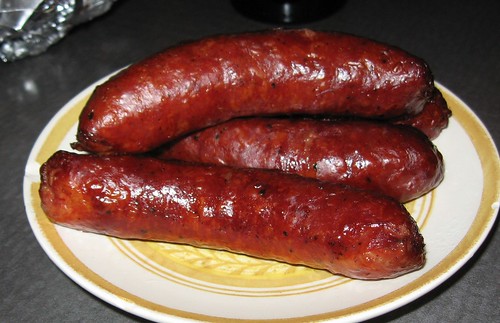
In the grocer's meat case, there is no shortage of products called "smoked" sausage. Most of these products are bland.
This past weekend, we were in Newark, Ohio and ate at a place called Dicky's. Chain bbq place, but good. Had some lovely smoked kielbasa (or brats?) and immediately, I had a mission.
My new favorite hangout online these days is The Virtual Weber Bullet Forums. Perhaps the most informative and civil forum I've ever visited. Lots of good information and courteous contributors. From a discussion today, I gleaned I should smoke sausage low 'n slow, with apple wood if possible and to an internal temp of 170F. I got some kielbasa from Giant-Eagle today, smoked between 250-275F (dome temperature) for about 2 hours using lump with a mixture of mesquite and lump. I took 'em off at an internal of 180F because I was distracted socializing around the neighborhood. However, they smelled so good, we almost had them as a second dinner.
I wrapped them and put them in the fridge. I may make use them in red beans and rice. Not sure. For now, I'll just stand in the fridge and smell the smokiness of a real smoked sausage.
3.17.2008
If Weber-Stephens gave Nobel Prizes, I would be the laureate for 2008.

Ever since I managed to discover the dome vent method for temperature regulation during long smoking sessions, I've regained new interest in my kettles. I bring my blue one flowers daily.
I've gone one step further with my new mod. With the temperature regulation handily taken care of, I now wanted it to be easier to stop and start for my indirect sessions. When the lump charcoal is loaded on one side, it works fine, but to stop and restart, one has to re-stack the fuel, get messy and light it again. With a chimney inserted in the kettle, the fuel could dispense itself perfectly and the burned stuff just falls out. But, could the chimney be placed right inside the kettle? With a little cutting, no problem.
I lost a bit of cooking surface, a tad less than with normal indirect, but gained ease of operation. I stack in the fuel, ignite it, let it rip ... tonight I did a chicken (with mesquite and maple) at 330-deg-F for 1.5 hours ... close the vents and finish. The remaining fuel is still loaded and ready to go for the next session. No re-stacking the fuel, just toss another piece of paper in and light it and ready to go in about 10 minutes (tonight's fired up in about 5-10 minutes, 1 match). This chicken was prepared while we ate dinner. After it was done, I wrapped it up to contain the smoky goodness and it's ready for dinner tomorrow.
Update
Been hanging out on the Weber Bullet forums the past day asking about dome vent temp control and realized I made a huge mistake. Or, I conducted a method prone to overheating. The setup should remain the same. However, the chimney should not be lit from the bottom. This will quickly ignite ALL of the fuel making for one vicious mound of heat. Using something called the minion method, I should have lit a few pieces of fuel and placed them on top of the fuel. And the fuel should contain several pieces of smoke wood in the pile. Then, as the lit coals proceed to ignite fuel below them the burn will commence in a slower manner than all the fuel ignited at once.
The chicken was still killer but the heat source was hard to control. Can't wait for another run. Same set up, just minion method and I'm there. May even be able to keep the top vent open if the fuel burns slower. Keep you posted on further developments.
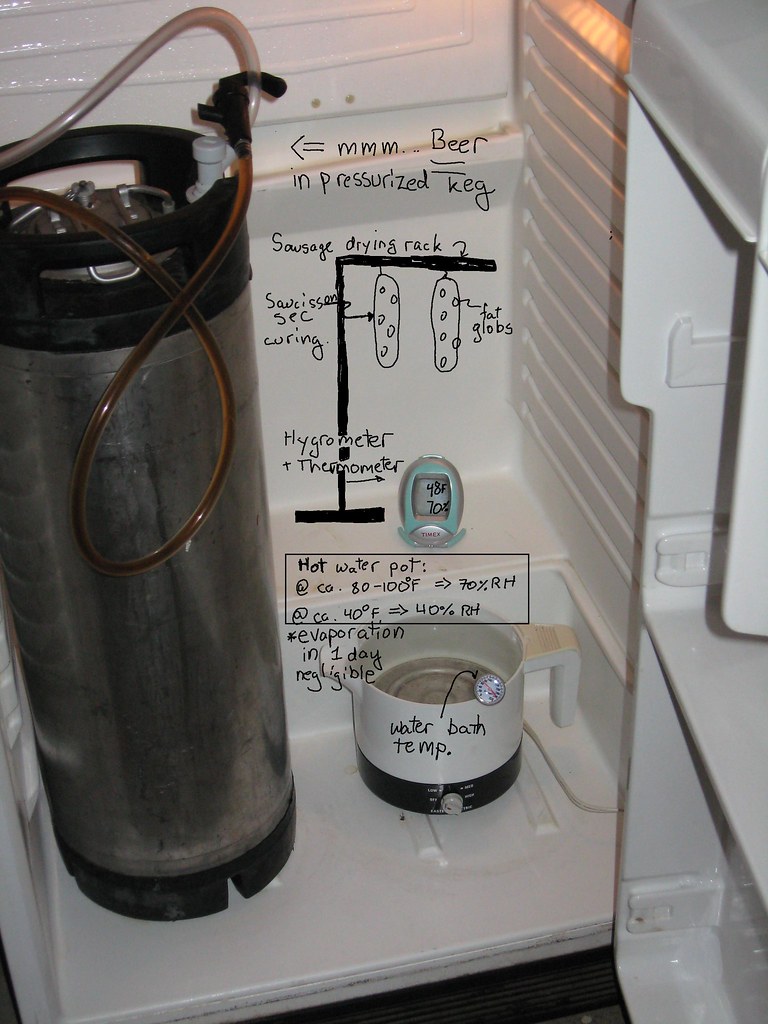
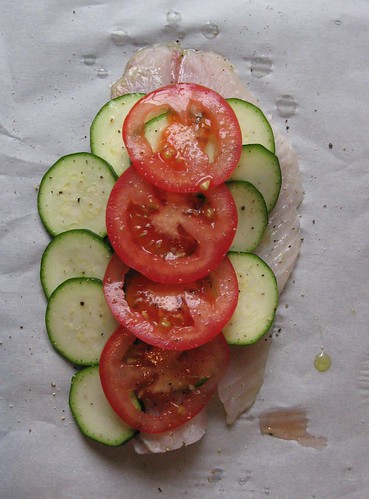
![smoked tofu [2/5]](http://farm4.static.flickr.com/3064/2401561969_b285a05fd2_m.jpg)
![smoked tofu [4/5]](http://farm3.static.flickr.com/2088/2401563139_c628f251a8_m.jpg)
![smoke_temp_tofu [tofu 1/5]](http://farm4.static.flickr.com/3125/2402389766_554b580e76_m.jpg)
![smoked tofu [5/5]](http://farm4.static.flickr.com/3165/2402392308_fb37cdd4e7_m.jpg)




